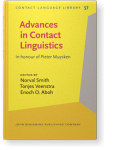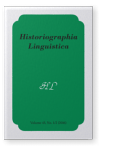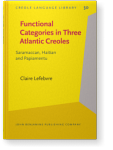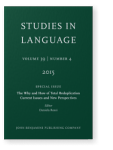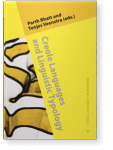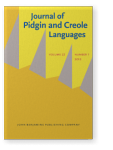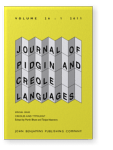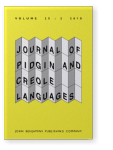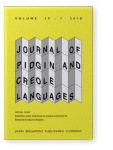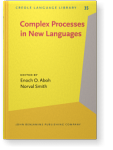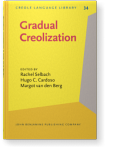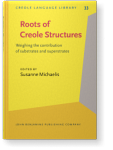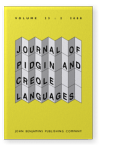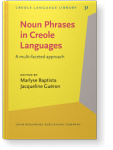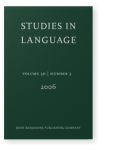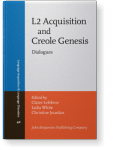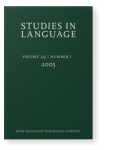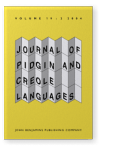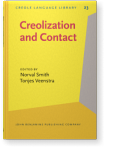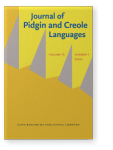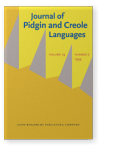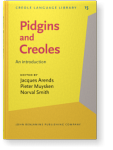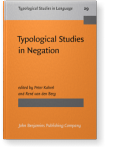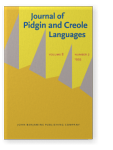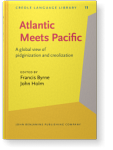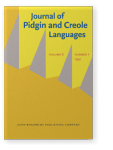Silvia Kouwenberg
List of John Benjamins publications for which Silvia Kouwenberg plays a role.
Book series
2020 Are creoles a special type of language? Methodological issues in new approaches to an old question Advances in Contact Linguistics: In honour of Pieter Muysken, Smith, Norval, Tonjes Veenstra and Enoch O. Aboh (eds.), pp. 107–158 | Chapter
This paper takes as its starting point Muysken’s (1988a: 300) view of a ‘creole’ language as “just a language.” With this statement, Muysken rejects the idea of a creole prototype. Over the past 20 years, that idea has seen several new proponents. We provide a brief overview, before turning our… read more
2017 The sociohistorical matrix of creolization and the role children played in this process Language Contact in Africa and the African Diaspora in the Americas: In honor of John V. Singler, Cutler, Cecelia, Zvjezdana Vrzić and Philipp Angermeyer (eds.), pp. 79–100 | Chapter
This paper will take as its starting point Singler’s views on the role of children in creole genesis, which include the idea that children are regularizers rather than innovators, that they may have contributed lexifier properties, and that their potential as contributors to creole genesis is… read more
2016 Nineteenth-Century Creolist Work and Its Reflections on Language and Community Historiographia Linguistica 43:1/2, pp. 209–222 | Review article
2015 Chapter 8. A new analysis of the Papiamentu clause structure Functional Categories in Three Atlantic Creoles: Saramaccan, Haitian and Papiamentu, Lefebvre, Claire, pp. 283–315 | Article
This chapter reconsiders the complementizer and the tense-mood-aspect systems of the Papiamentu clause within the framework of the split CP (Rizzi 1997) and the split INFL (Pollock 1989) hypotheses, providing new evidence for the left periphery heads. It provides a detailed account of the… read more
2015 Arbitrariness and iconicity in total reduplication: Evidence from Caribbean Creoles The Why and How of Total Reduplication: Current Issues and New Perspectives, Rossi, Daniela (ed.), pp. 971–991 | Article
This article explores the iconicity of Total Reduplication (TR) and considers how iconicity is manifested in the reduplication of object, event, and attribute-denoting forms in Caribbean Creole (CC) languages. We argue that TR naturally lends itself to a “more of the same content” interpretation,… read more
2013 The typology of Caribbean Creole reduplication Creole Languages and Linguistic Typology, Bhatt, Parth and Tonjes Veenstra (eds.), pp. 245–268 | Article
Although many aspects of Creole languages remain relatively unexplored, the morphology of Creole languages has been especially neglected. This is largely because it is still widely believed that Creoles have very little in the way of morphology, even compared to an inflection-poor language such as… read more
2012 Rejoinder Journal of Pidgin and Creole Languages 27:1, pp. 167–169 | Article
2011 A Tribute to Norval Smith Journal of Pidgin and Creole Languages 26:2, pp. 235–246 | Article
2011 Linguistics in the Caribbean: Between theory and practice Creoles and Typology, Bhatt, Parth and Tonjes Veenstra (eds.), pp. 219–233 | Article
2011 The typology of Caribbean Creole reduplication Creoles and Typology, Bhatt, Parth and Tonjes Veenstra (eds.), pp. 194–218 | Article
Although many aspects of Creole languages remain relatively unexplored, the morphology of Creole languages has been especially neglected. This is largely because it is still widely believed that Creoles have very little in the way of morphology, even compared to an inflection-poor language such as… read more
2010 Creole studies and linguistic typology: Part"2 Journal of Pidgin and Creole Languages 25:2, pp. 359–380 | Article
2010 Creole studies and linguistic typology: Part 1 Pidgins and Creoles in Asian Contexts, Ansaldo, Umberto (ed.), pp. 173–186 | Article
2009 The invisible hand in creole genesis: Reanalysis in the formation of Berbice Dutch Complex Processes in New Languages, Aboh, Enoch O. and Norval Smith (eds.), pp. 115–158 | Article
This paper considers the historical context in which Berbice Dutch was formed before turning to the significance of the presence in that language of function words derived from the Eastern Ịjọ substrate. The view that transfer of Eastern Ịjọ grammatical properties took place in the formation of… read more
2009 The demographic context of creolization in early English Jamaica, 1655-1700 Gradual Creolization: Studies celebrating Jacques Arends, Selbach, Rachel, Hugo C. Cardoso and Margot van den Berg (eds.), pp. 327–348 | Article
Jamaica’s plantation economy was established during the final quarter of the seventeenth century, after an initial two decades during which the economy of English Jamaica was dominated by privateering, centred around the prize market established in Port Royal. Population figures for those first two… read more
2008 1. The problem of multiple substrates: The case of Jamaican Creole Roots of Creole Structures: Weighing the contribution of substrates and superstrates, Michaelis, Susanne Maria (ed.), pp. 1–27 | Article
In this paper, I argue that the late seventeenth-century context in which Jamaican Creole emerged was one of multilingualism within the slave population, with no evidence for a dominant substrate language. This finding goes against established scholarship, which has claimed Akan as the dominant… read more
2008 Review of Nero (2006): Dialects, Englishes, creoles and education Journal of Pidgin and Creole Languages 23:2, pp. 356–359 | Review
2007 16. Bare nouns in Berbice Dutch Creole Noun Phrases in Creole Languages: A multi-faceted approach, Baptista, Marlyse and Jacqueline Guéron (eds.), pp. 437–458 | Chapter
Berbice Dutch determinerless nouns occur frequently in factive contexts, as specific reference nouns – an unexpected finding, as specific reference is usually associated with definiteness, and Berbice Dutch does not lack a definite article. I argue that specific reference as established in… read more
2006 Review of Aceto & Williams (2003): Contact Englishes of the Eastern Caribbean Studies in Language 30:3, pp. 651–654 | Review
2006 LI transfer and the cut-off point for L2 acquisition processes in Creole formation L2 Acquisition and Creole Genesis: Dialogues, Lefebvre, Claire, Lydia White and Christine Jourdan (eds.), pp. 205–219 | Article
2005 Review of Baptista (2002): The Syntax of Cape Verdean Creole. The Sotavento Varieties Studies in Language 29:1, pp. 255–259 | Review
2001 9. Convergence and explanations in creole genesis Creolization and Contact, Smith, Norval and Tonjes Veenstra (eds.), pp. 219–248 | Article
1996 Substrate or Superstrate: What's in a Name Journal of Pidgin and Creole Languages 11:2, pp. 343–347 | To be specified
1994 9. Theories focusing on the non-European input Pidgins and Creoles: An introduction, Arends, Jacques, Pieter Muysken and Norval Smith (eds.), pp. 99–109 | Chapter
1994 Berbrice Dutch Typological Studies in Negation, Kahrel, Peter and René van den Berg (eds.), pp. 237–266 | Article
1994 19. Berbice Dutch Pidgins and Creoles: An introduction, Arends, Jacques, Pieter Muysken and Norval Smith (eds.), pp. 233–243 | Chapter
1994 17. Papiamento Pidgins and Creoles: An introduction, Arends, Jacques, Pieter Muysken and Norval Smith (eds.), pp. 205–218 | Chapter
1993 Cliticization of pronouns in Berbice Dutch and Eastern Ijo Atlantic Meets Pacific: A global view of pidginization and creolization, Byrne, Francis and John Holm † (eds.), pp. 119–132 | Article
1989 Review of Smith (1987): The genesis of the creole languages of Surinam Journal of Pidgin and Creole Languages 4:2, pp. 298–305 | Review


